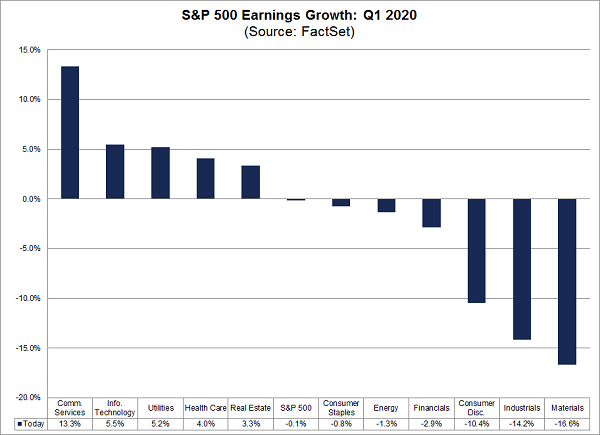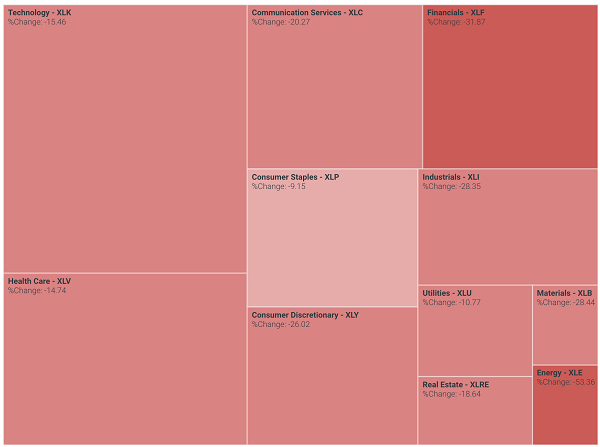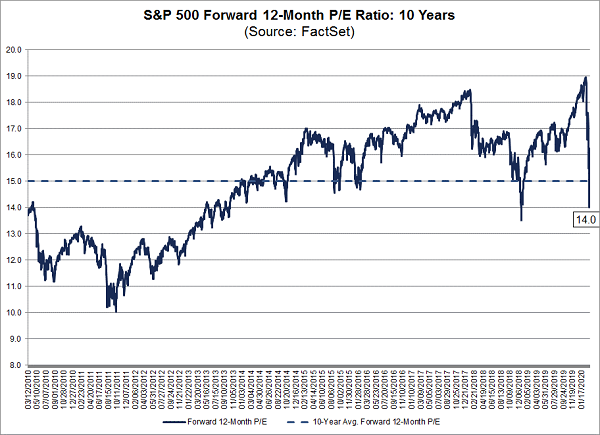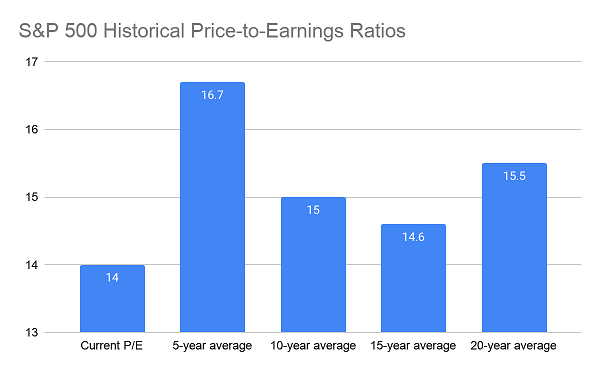Markets have freaked out over the coronavirus—but there’s good reason to believe they have overreacted—I gave you a few of these reasons in my March 19 article.
There’s another reason we need to talk about today: corporate earnings.
At the start of the quarter, analysts expected 4.4% earnings growth from S&P 500 companies.
Now they’re expecting a 0.1% earnings decline.
That’s basically flat, and it’s better than the earnings declines we saw at the start of 2019, when stocks were rallying, so this news shouldn’t scare investors away.
Much more importantly, the earnings declines aren’t evenly distributed among all sectors.
Coronavirus: The Earnings Story
 The five sectors that are still forecast to see growth are, in total, about 60% of the market, while the sectors with the biggest expected earnings declines make up just 20% of the market. Overall, the impact to stocks is relatively concentrated. And yet, we see panic selling across the board:
The five sectors that are still forecast to see growth are, in total, about 60% of the market, while the sectors with the biggest expected earnings declines make up just 20% of the market. Overall, the impact to stocks is relatively concentrated. And yet, we see panic selling across the board:
Indiscriminate Selling Everywhere
 More importantly, those sectors where earnings aren’t expected to fall have still seen their stocks crater amidst the selloff. This creates opportunities to get into utilities, for example. And you can do that with a closed-end fund (CEF) called the Gabelli Global Utility & Income Trust (GLU), yielding 10.9% as I write this.
More importantly, those sectors where earnings aren’t expected to fall have still seen their stocks crater amidst the selloff. This creates opportunities to get into utilities, for example. And you can do that with a closed-end fund (CEF) called the Gabelli Global Utility & Income Trust (GLU), yielding 10.9% as I write this.
Or you can grab a 9.2% dividend from technology stocks with the BlackRock Science and Technology Trust II (BSTZ). Another option, for broader index exposure, is the Nuveen S&P 500 Buy-Write Income Fund (BXMX), with an 11.2% dividend as I write.
Earnings: Now on Fire Sale
Of course, this earnings story isn’t going to ease fear of the coronavirus, so why should we even think about buying stocks until this pandemic blows over?
The immediate answer is that stocks are a leading indicator, and they will price in a recovery before it begins. That’s why stocks have been having green days after they crash; bulls see signs in news developments that the pandemic will end, only to be rebuked by the bears, who say we’re not out of the woods yet.
 There is a crucial bit of the story in the bulls’ favor, even if we expect an economic recession due to the virus. Namely, while stock prices look cheap right now, stock earnings are extremely cheap.
There is a crucial bit of the story in the bulls’ favor, even if we expect an economic recession due to the virus. Namely, while stock prices look cheap right now, stock earnings are extremely cheap.
There are two ways to think about buying a stock. One is that you pay the price of a share and in exchange you get that ownership in a company. If Company XYZ has a million shares at $10 each and you buy one for $10, you own one one-millionth of Company XYZ. This is the normal way that average investors think about stocks.
It isn’t how pros think about stocks, though. Yes, you’re getting a millionth of XYZ in this example, but you’re not just getting equity in the company—you’re also getting (at least in theory) the right to a millionth of XYZ’s earnings. You’re buying the rights to their profits, and when stock prices fall and the total amount of stocks in a company doesn’t change, you’re getting more earnings per dollar.
This is captured in the price-to-earnings ratio of a stock, and this basic metric has been a major indicator of stock valuations for decades. Right now, the average P/E ratio of the S&P 500 is 14, a huge drop from the ratio of 19 it stood at just a couple months ago. Much more importantly, it’s also lower than its long-term averages.
 Source: CEF Insider
Source: CEF Insider
As you can see, the market’s current P/E ratio is lower than its averages over the last two decades, making this the cheapest stock market in a generation.
That likely won’t last long, though. Everyone is looking at these data points, and some investors are gathering the courage to jump back in. My conclusion here is that the bold and the patient among this group will be rewarded with strong profits in the long run.
— Michael Foster
4 More Sturdy 8%+ Dividends to Buy in This Storm [sponsor]
In a market wipeout like the one we’re living through, a proven strategy is to get as much of your return in dividend cash as possible—even if you’re not counting on your portfolio for income.
After all, the steady drip, drip, drip of dividends naturally increases your portfolio’s cash position and cuts your volatility in times like these. And you’ll be in even better shape if you put some of your money to work in the 4 high-dividend CEFs (I’m talking 8.4%+ average payouts here) I’ll show you right here.
As I write, these CEFs sport once-in-a-generation valuations, thanks to the selloff. Those deep discounts add some stability to their share prices—and set you up for fast upside when the coronavirus threat subsides. And of course, while you wait, you’ll be bagging a nice 8.4%+ average payout from these funds.
The full story on each of these 4 picks is waiting for you now. Click here and I’ll give you full details: names, tickers, buy-under prices, dividend histories and much more.
Source: Contrarian Outlook
